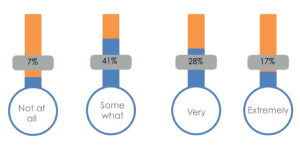Traditionally in the health and physical education space we have spent most of our time telling students what to do or what not to do. For example, we tell students “they should eat a healthy diet”, “they should be physically active” and we tell them “don’t smoke”, “don’t binge drink”. As Jill Stark in The Age coined it – we are giving the uninvited lecture. All that young people are hearing in this conversation is “blah, blah, blah”.
Anecdotally I think we’ve all known this for a while, particularly those of you who are the parent of a teenager. However, research is now emerging that supports the need for a shift in our approach to conversations about health and wellbeing.
Recent research released by the Australian Research Centre for Sex and Health in Society (ARCSHS) at La Trobe University provides evidence that the traditional delivery of sexuality education in schools is failing to meet the needs of students.
The National Secondary Students’ Sexual Health Survey involved more than 2,000 students in years 10, 11 and 12 at Government, Catholic and Independent schools in all states and territories. The results found that “50% of young people expressed significant dissatisfaction with sex education at school, citing irrelevance to their real experiences, lack of relationship advice and lack of discussion of same-sex issues as problems”. (Mitchell A, 2014)
The data also showed that 7% of students reported not receiving any sex education at all … now I’m not even going to go there as that is a whole other issue that deserves a whole post to itself!
But it’s not all a bad news story as the following video shows.
The research also reported some very promising data including:
- 31% of the respondents reported that they had never participated in any sexual activity
- around one half of non-sexually active students reported that they did not feel ready to have sex; that they were proud to say no and mean it, and that they thought it important to be in love the first time they had sex
- relatively low proportions of students reported frequent cyberbullying in the last couple of months
- most common cyberbullying behaviours ‘every few weeks or more’ were receiving prank mobile phone calls (10%) and being deliberately ignored or left out of things over the Internet (9%)
- 40% of students reported never drinking alcohol
the vast majority of students (81%) have never smoked cigarettes - only 4% report smoking regularly
- 83% of students report never having smoked marijuana, with only 3% reporting regular use of marijuana.
So to begin our teaching from a starting point of deficit, e.g. the assumption that ALL students will be participating in harmful or risky behaviours is doing a disservice to those students who are not participating in harmful or risky behaviours.
This growing evidence supports the underpinning framework of the new Australian Curriculum. Rather than focusing only on potential health risks or a deficit-based model of health, the curriculum has a stronger focus on supporting students to develop the knowledge, understanding and skills (those personal assets and strengths) they require to make healthy, safe and active choices that will enhance their own and others’ health and wellbeing.
Rebecca Alber in her article titled Ditching the deficit model identifies 5 learning strategies that teachers can use to help students to identify their strengths and personal assets or as she calls them their “jewels”. They are:
- Goal Setting.
- What I Know Well
- Learning Inventories
- Artifact from My Life
- Takeaways.
Check out Rebecca’s post for more information about each of these strategies and how you might use them in your classroom.
A strengths-based approach is not reserved only for health education. Cote & Mallett in 2013 explored the use of positive psychology in sport and coaching in an effort to recognise and develop a strengths or assets-based approach to sport, coaching and physical activity. Sandy Gordon, in a presentation at the WA Health Conference in 2011 used cricket to demonstrate how a strengths-based approach can be used when considering elite movement performance. In her presentation she describes how Australian cricketer Marcus North was asked to consider a series of questions about his batting using a strengths-based approach. Below are his responses as reported in Gordon’s presentation:
Question: My strengths are … I feel strong when I am … {doing this}
“I feel strong when I am coming into bat when the innings needs rescuing or a game is to be won.”
Question: What is your best shot? How do you get most of your runs?
“Straight drive”
Question: I deliver my best and feel in my element doing what?
“Rebuilding an innings when the team is in trouble. Guiding the team to victory using a calm and clever mind set. Involving myself in the contest.”
Question: My favourite role(s) that I find most stimulating is (are)
“Being the player that stands up during the tough times and most difficult periods of play”
Question: Things I can do to build on my strengths, put myself into situations where I am in my element are …
“To train mostly by simulating tough game situations under greater pressure”
As a teacher, you could use similar questions with your students to get them to think about their strengths in different movement activities and contexts and to focus on these strengths in order to improve movement performances. This is just scraping the surface of how the strengths-based approach can be translated into practice.
How will you incorporate a strengths-based approach in your lessons?
Further reading on a strengths-based approach in the Health and Physical Education curriculum
Louise McCuaig , Mikael Quennerstedt & Doune Macdonald (2013): A salutogenic, strengths-based approach as a theory to guide HPE curriculum change, Asia-Pacific Journal of Health, Sport and Physical Education, 4:2, 109-125
Australian Curriculum, Assessment and Reporting Authority [ACARA] (2014)
Draft Australian Health and Physical Education (HPE) curriculum (http://www.australiancurriculum.edu.au/health-and-physical-education/Curriculum/F-10?layout=1)

